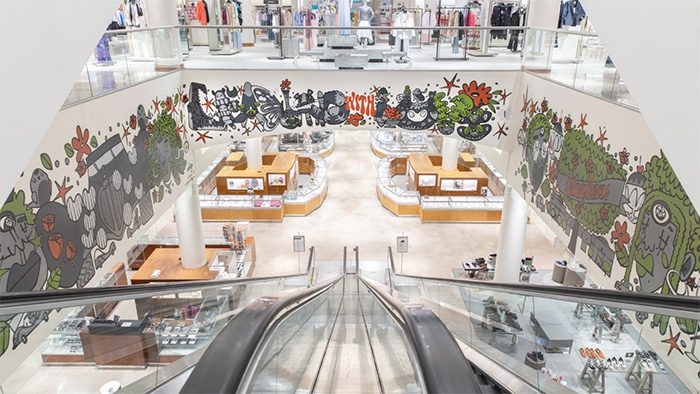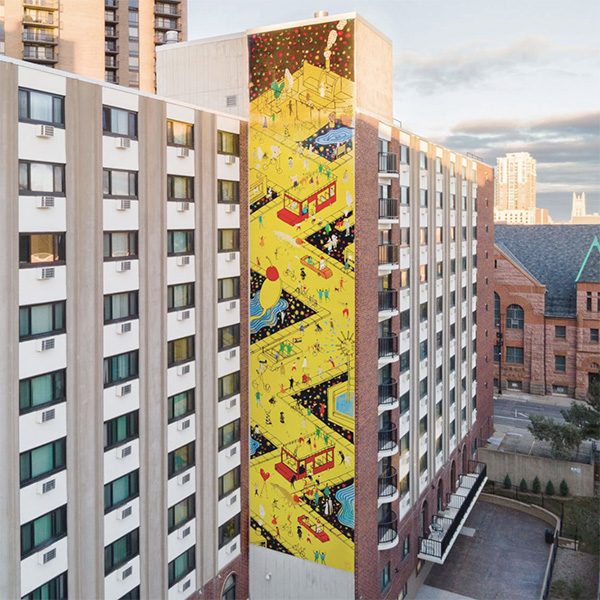Companies seek innovative ways to differentiate themselves. Many are turning to an age-old art form with a modern twist: custom murals. These large-scale artworks are changing commercial spaces, telling brand stories, and creating immersive experiences for employees and customers alike. Let’s examine how custom murals, a result of companies choosing to commission art, are changing the way businesses approach their physical environments.
The Evolution of Murals in Corporate Spaces
Murals have a rich history dating back to ancient cave paintings, but their role in the business world is a relatively recent phenomenon. In the mid-20th century, companies began to recognize the potential of murals to strengthen brand identity and create engaging spaces. This shift marked a significant change in how businesses viewed their physical environments and led to more companies deciding to commission art.
Where once murals were primarily used to depict religious themes or commemorate historical events, they now function for corporate storytelling and brand expression when businesses commission art.
Consider the influence of artists like Diego Rivera, whose murals in the early 20th century used walls as canvases for social commentary. Rivera’s work inspired a generation of artists to think on a grand scale, using expansive spaces to convey complex messages. Today’s commercial murals, created when companies commission art, draw on this tradition, but instead of political messages, they’re conveying brand values, company histories, and corporate visions.

Ansel Adams, Diego Rivera Painting the Fresco “Still Life and Blossoming Almond Trees, 1930–31; collection SFMOMA, Albert M. Bender Collection, gift of Albert M. Bender; © The Ansel Adams Publishing Rights Trust
This evolution hasn’t been without controversy. Some critics argue that the use of mural art in commercial spaces dilutes its effectiveness as a tool for social change. However, proponents counter that these murals, resulting from decisions to commission art, can function for both aesthetic and practical purposes, improving work environments while also communicating important messages about a company’s principles and goals.
Advantages of Commissioning Custom Murals
When a business decides to commission art for a custom mural, they’re making an investment. These artworks offer a range of advantages that can significantly affect a company’s success. Here are some of the potential benefits for both the company, its customers, and employees.
Brand Identity Through Visual Storytelling
Murals can effectively communicate a brand’s narrative through a single, compelling image. Unlike traditional advertising or marketing materials, murals offer a visual approach that conveys a company’s values, mission, and identity in a format that resonates with viewers. This visual medium allows businesses to present their core message in a way that is both memorable and impactful for employees and visitors.
Imagine walking into a tech startup’s office and seeing a mural that depicts the company’s progression from a garage startup to a global innovator showing a winding road through a futuristic landscape, with milestones represented by increasingly complex machines, and a rocket ship heading towards new horizons. This single image can convey the company’s history, values, and aspirations more effectively than any mission statement or corporate brochure.
The versatility of murals allows for many possibilities in storytelling when businesses commission art. Some companies opt for realistic depictions of their products or services in action, while others choose abstract representations that suggest the emotions associated with their brand. The key is to work closely with artists who can translate corporate values and goals into compelling visual narratives when companies commission art.
Additionally, murals offer a way to keep a brand story current and evolving. Unlike static mission statements or traditional corporate artwork, murals can be designed with growth in mind. Some companies are even experimenting with digital murals when they commission art, which can be updated regularly, allowing for seasonal themes or the celebration of key company moments.

Celebrating love and connection, this mural by Tony Whlgn transforms Neiman Marcus, Troy into a vibrant reflection of Detroit’s spirit.
Employee Engagement and Company Culture
Murals can also have a strong influence on company culture and employee morale. A well-executed mural can function as a daily source of inspiration and motivation. It’s a constant visual reminder of the company’s values and goals, helping to align employees with the broader corporate vision. In this way, a mural becomes a tool for organizational alignment and culture building.
Some companies have used murals as a collaborative tool that helps create a sense of ownership and pride in the workplace. When employees are involved in the mural creation process—whether through brainstorming sessions, voting on designs, or even participating in the painting—they see their ideas reflected in something long term, which makes them feel connected to the company mission and vision. This collaborative approach can reduce hierarchical barriers, encourage creativity across all departments, and create a shared sense of purpose.
Community Impact
In consumer-centric spaces, murals can improve the customer experience, turning a simple storefront into a local point of interest or a plain waiting area into an engaging visual experience, resulting in tangible economic benefits to the company.
Businesses with eye-catching murals often report increased foot traffic and customer engagement, and return visits. In retail environments, murals can influence customer behavior, guiding shoppers through the space or even subtly influencing purchasing decisions.
On a broader scale, exterior murals can contribute to community revitalization. By turning buildings into works of art, businesses can add to the cultural fabric of their neighborhoods, potentially sparking wider urban renewal efforts. This not only improves a company’s reputation as a community partner but can also lead to positive press and increased brand recognition.

Ryan Peltier’s vibrant mural at Shoreline Plaza captures the spirit of community and collaboration, celebrating local pride with iconic landmarks and dynamic imagery.
The Commission Art Process
While the benefits of custom murals are clear, the process to commission art can be complex. It requires careful planning, clear communication, and a willingness to embrace the creative process.
The first step is defining clear objectives for the mural. What story do you want to tell? What emotions do you want to evoke? How does this artwork fit into your broader branding and marketing strategies? These questions should be thoroughly explored before any artist is approached to commission art.
Selecting the right artist is essential when you commission art. Look for someone who not only has a style that aligns with your vision but also has experience working on large-scale commercial projects. The ability to translate corporate ideas into compelling visuals is a unique skill that not all artists possess.
Once an artist is selected to commission art, the collaborative process begins. This typically involves multiple rounds of sketches and revisions, with input from various stakeholders. It’s important to strike a balance between providing clear direction and allowing the artist creative freedom.
The actual creation of the mural is often the most exciting part of the process when you commission art. Depending on the scale and complexity of the design, this could take anywhere from a few days to several weeks. Many companies choose to document this process, using time-lapse videos or behind-the-scenes photos as additional marketing content.
This process may seem daunting and time-consuming, but the rewards are often well worth it. However, for some businesses, the challenge lies in not having employees with the necessary skills to manage the process, the time to dedicate to it, or the expertise to discern quality art and connect with the right artists. In such cases, hiring an art consultancy can be a practical solution. These professionals can handle the entire process, leveraging their deep understanding of art and extensive artist networks to streamline the project. Their expertise often allows them to manage projects more cost-effectively, freeing up company employees to focus on their primary responsibilities. Additionally, art consultants can take care of budgets, contracts, legal considerations, and permits, ensuring that the project runs smoothly from start to finish.
Finally, don’t underestimate the importance of the unveiling when you commission art. A well-planned reveal event can generate interest, attract media attention, and serve as a powerful branding moment. Art consultancies like ATP.art can assist with this process, offering media services that include creating compelling content, managing social media campaigns, and even documenting the unveiling through photography and video.
The Future of Murals in Commercial Spaces
As the world of corporate branding continues to evolve, the role of murals as a form of commissioned art is only set to grow. Beyond just enhancing physical spaces, these murals are becoming a vital part of a company’s narrative and identity. They engage not only employees and customers but also the wider community, creating lasting impressions and fostering deeper connections. With the increasing need for businesses to stand out in a competitive market, could commissioning art for murals be the next essential step in your corporate strategy? How do you envision the perfect mural transforming your workspace and brand identity? Let us know what your plans are in the comment below.
